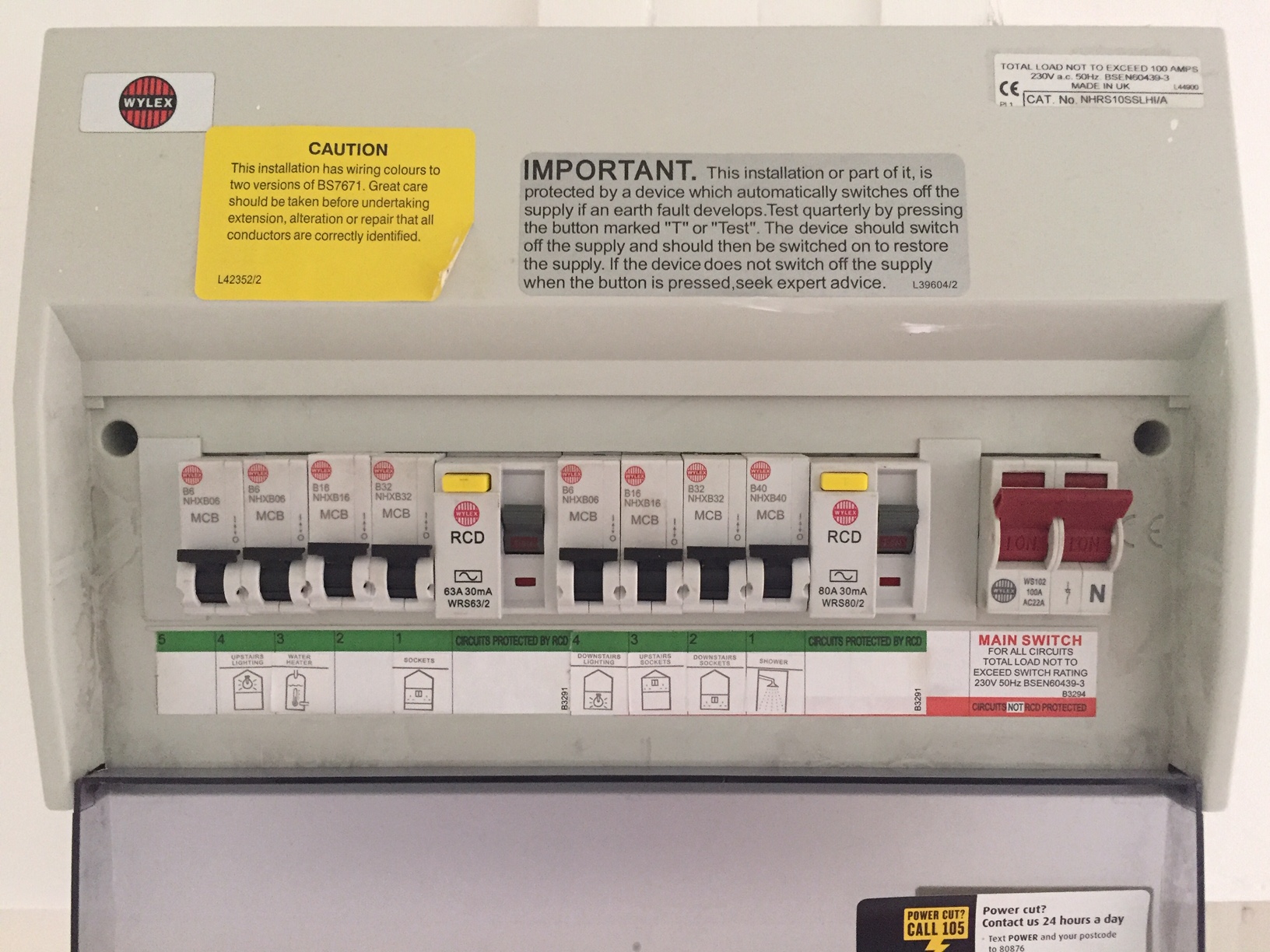Consumer unit
This term 'consumer unit' is now officially defined within the 2018 edition of BS 7671 (IET Wiring Regulations) as:
| A particular type of distribution board comprising a type-tested co-ordinated assembly for the control and distribution of electrical energy, principally in domestic premises, incorporating manual means of double pole isolation on the incoming circuit(s) and an assembly of one or more fuses, circuit breakers, residual current operated devices or signalling and another control devices proven during the type-test of the assembly as suitable for such use. |
To many, the consumer unit is the modern-day equivalent of a ‘fuse box’ or ‘fuse board’ and provides the origin of all outgoing final circuits.
Successive evolutions of BS 7671 over the last few decades have seen the requirements for consumer units grow substantially – not only in what they may house, but also their construction – particularly in recent years with regards to increased fire safety.
The most recent version of BS 7671 in 2018 (the 18th Edition) now imposes much greater emphasis on ensuring that all such equipment that may be housed in such a consumer unit, often to fulfil specific individual purposes, is properly considered with respect to how it performs alongside other equipment in its vicinity. This will include attributes such as thermal performance, magnetic effects, fixing details and terminations, ability to withstand fault levels as well as current carrying capacity.
--ECA
NB Housing statistics and English Housing Survey, glossary, published by the Department for Levelling Up, Housing and Communities in 2019, states: ‘…in older systems, each individual electrical circuit was fed through an individual switch and fuse box. From 1960s through to the 1980s, fuses were collected together into a small number of smaller boxes, normally with a switch on the front which controlled all the circuits leading to the box. These boxes were normally fitted with a cover, the removal of which gave access to the fuses hidden inside. From the early 1980s, the newly named consumer unit (some dwellings have 2) catered for the whole dwelling and was also designed to accommodate modern safety measures namely circuit breakers and residual current devices.’
Related articles on Designing Buildings
- Articles about electricity.
- Circuit breaker.
- Consumer electronics.
- Domestic micro-generation.
- ECA articles.
- Electric motor.
- Electrical appliance.
- Electrical component.
- Electrical consumption.
- Electrical energy.
- Electrical installation.
- Electrical power.
- Electrician.
- Electrical safety.
- Electricity bill.
- Electricity supply.
- Flexible electrical networks for a low carbon future.
- Fuse.
- Glossary of electrical terms.
- Miniature circuit breaker.
- Panelboard.
- Radial circuit.
- Residual current device.
- The Future of Electricity in Domestic Buildings.
Featured articles and news
UK Infrastructure: A 10 Year Strategy. In brief with reactions
With the National Infrastructure and Service Transformation Authority (NISTA).
Ebenezer Howard: inventor of the garden city. Book review.
The Grenfell Tower fire, eight years on
A time to pause and reflect as Dubai tower block fire reported just before anniversary.
Airtightness Topic Guide BSRIA TG 27/2025
Explaining the basics of airtightness, what it is, why it's important, when it's required and how it's carried out.
Construction contract awards hit lowest point of 2025
Plummeting for second consecutive month, intensifying concerns for housing and infrastructure goals.
Understanding Mental Health in the Built Environment 2025
Examining the state of mental health in construction, shedding light on levels of stress, anxiety and depression.
The benefits of engaging with insulation manufacturers
When considering ground floor constructions.
Lighting Industry endorses Blueprint for Electrification
The Lighting Industry Association fully supports the ECA Blueprint as a timely, urgent call to action.
BSRIA Sentinel Clerk of Works Training Case Study
Strengthening expertise to enhance service delivery with integrated cutting-edge industry knowledge.
Impact report from the Supply Chain Sustainability School
Free sustainability skills, training and support delivered to thousands of UK companies to help cut carbon.
The Building Safety Forum at the Installershow 2025
With speakers confirmed for 24 June as part of Building Safety Week.
The UK’s largest air pollution campaign.
Future Homes Standard, now includes solar, but what else?
Will the new standard, due to in the Autumn, go far enough in terms of performance ?
BSRIA Briefing: Cleaner Air, Better tomorrow
A look back at issues relating to inside and outside air quality, discussed during the BSRIA briefing in 2023.
Restoring Abbotsford's hothouse
Bringing the writer Walter Scott's garden to life.
Reflections on the spending review with CIAT.
Retired firefighter cycles world to raise Grenfell funds
Leaving on 14 June 2025 Stephen will raise money for youth and schools through the Grenfell Foundation.
Key points for construction at a glance with industry reactions.


























Comments
[edit] To make a comment about this article, click 'Add a comment' above. Separate your comments from any existing comments by inserting a horizontal line.